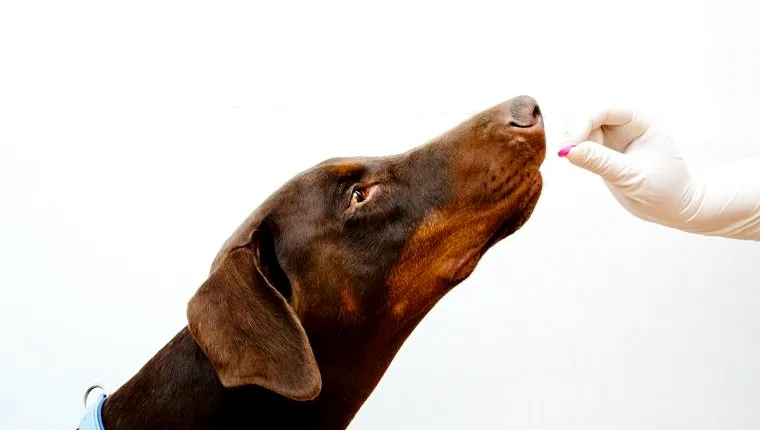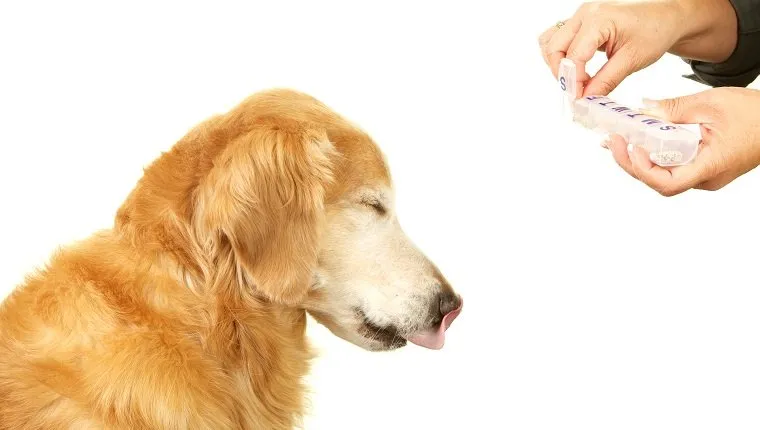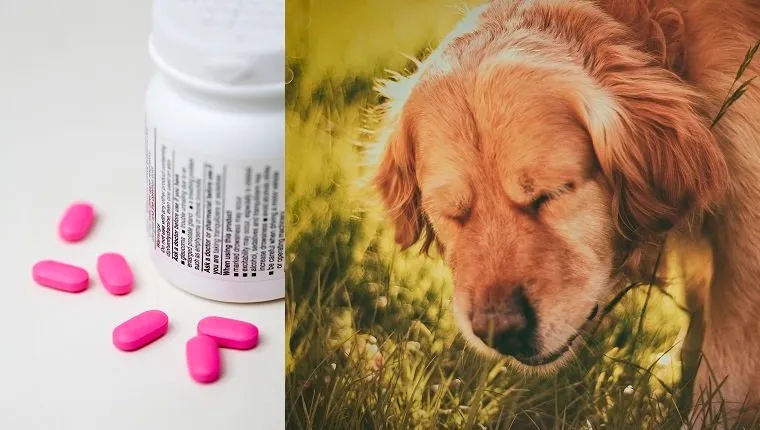Benadryl is a common over-the-counter medication for humans that can also be used to treat dogs who suffer from allergies if proper dosage and veterinary guidelines are followed. Some pet parents also give it to their dogs as a sedative, especially during noisy events like New Year’s Eve and 4th of July celebrations.
The most common active ingredient in Benadryl is diphenhydramine, which blocks histamine uptake, relieving inflammation and other allergy symptoms. Diphenhydramine is also the an active ingredient in sleep aids and is relatively safe for dogs with veterinary guidance.
You must always consult your veterinarian before giving your dog any medication, including Benadryl, to find out what dosage is appropriate, as well as potential side effects that you should be aware of.
You can easily purchase Benadryl online here or at any major drug store. Here’s what you should know about Benadryl and its uses for dogs.
What Is Benadryl?

Benadryl is an over-the-counter antihistamine that calms allergic reactions to environmental allergens, insect bites or stings, and certain vaccine reactions. Though it’s a human drug and not FDA approved for canines and other animals, you can give it to your dog safely with approval from your vet.
Benadryl is the brand name, not the name of the drug that treats allergies. There are many other brands that make similar products, and there are other drugs under the Benadryl brand that you must use caution to avoid.
Read the ingredients of the medication before giving it to your dog. Diphenhydramine is the active drug in Benadryl that’s safe for canines. Cetirizine may also be present, and while it may be safe, there’s no need to expose your dog to it if it isn’t necessary.
Some products also contain acetaminophen and pseudoephedrine, which are not safe for dogs. Do not use these products, as they are toxic to canines.
Benadryl Dosage For Dogs

The general dosage guideline for dogs is 1mg of Benadryl for every pound of body weight. However, you must always consult your veterinarian, as there are a number of factors that can change this dosage recommendation.
The average dosage included in one tablet is 25mg, so a 25-pound dog should be given one tablet. But you must check the dosage on the package; don’t assume that every product will be the same.
Stick to the pill form, as the liquid form may contain alcohol, which is toxic for dogs.
For small dogs, you may wish to use the children’s formula, which has less of the active ingredient and may be easier for you to measure out. The children’s formula of liquid Benadryl contains no alcohol.
There’s also a topical form that can help with itching. Follow your vet’s guidelines for any creams or gels.
You can give Benadryl to your dog every eight to twelve hours, so about two to three times per day. If you use the product frequently, it may begin to lose effectiveness over time.
In most cases, it’s better to administer medication before exposure to allergens. Follow your vet’s guidelines, and if they recommend a regimen, stick to it for the duration of your vet’s advisement even if symptoms seem to disappear.
It’s important to strictly follow your vet’s guidelines. Symptoms of an overdose of Benadryl in dogs include:
- Rapid heart rate
- Dilated pupils
- Agitation
- Constipation
- Seizures
These symptoms can become life threatening.
Some dogs may also have an allergic reaction to the drug, itself. Always keep an eye on your dog after their first exposure to the medication.
Uses Of Benadryl For Dogs

Benadryl reduces many of the symptoms of allergic reactions in dogs, including inflammation, watery eyes, headaches, itching and sneezing, and other symptoms. These reactions can come from a variety of sources, including environmental or seasonal allergens, stings and bites from insects, or medications and vaccines.
Because the active ingredient, diphenhydramine, is similar to the active ingredient in Dramamine, it can be used to treat feelings of nausea and travel sickness. It’s sometimes recommended before flights or car rides to reduce symptoms.
The sedative properties of Benadryl can also make it an effective treatment for anxiety. Some pet parents give it to their dogs during high-stress situations like fireworks or storms that may induce an anxiety attack.
Insomnia can also be treated with Benadryl, as it often helps the user fall asleep.
Side Effects Of Benadryl In Dogs & When To Avoid It

The side effects of Benadryl in dogs are similar to the side effects humans might experience with the drug. These include sleepiness, dry mouth, sluggishness, or urinary retention.
Some less common side effects that may appear include diarrhea, vomiting, rapid heartbeat, breathing problems, or loss of appetite. You should call your vet if these symptoms become severe.
There are some times when dogs should avoid Benadryl. Puppies may not be able to safely handle the drug, so ask your vet. Combining medications can also cause serious side effects, so if your dog is taking any other drugs, make sure your vet is aware.
Dogs who currently have, or have had in the past, certain conditions, including heart disease, lung disease, glaucoma, high blood pressure, enlarged prostate, bladder issues, or a previous bad reaction to Benadryl should not be given this medication. Dogs who are pregnant may see complications, as well.
If your dog cannot take Benadryl or you wish to avoid certain side effects, you may consult your vet about alternative medications, or you may find a natural approach to fighting the symptoms of allergies to be preferable.
You should still ask your vet if you decide to treat your dog with natural solutions to be sure of proper dosages.
You can order Benadryl online here. As an alternative, you can find supplements to help dogs with allergies here and supplements to keep dogs calm or reduce noise anxiety here!
Does your dog suffer from allergies? Do you use Benadryl or another product? Let us know in the comments below!









